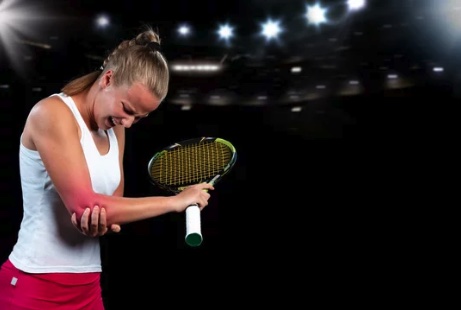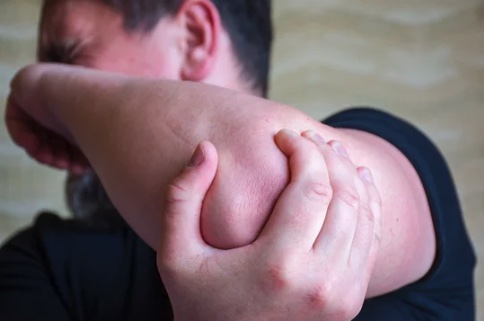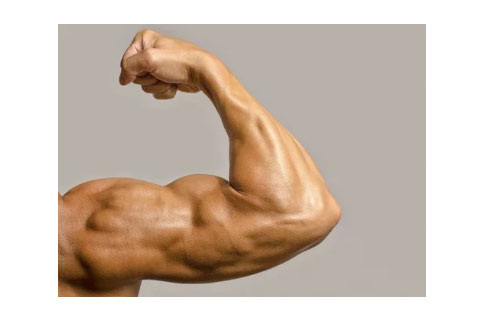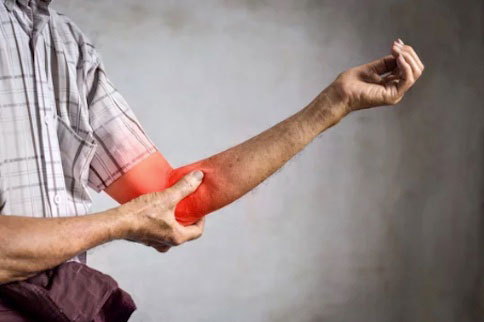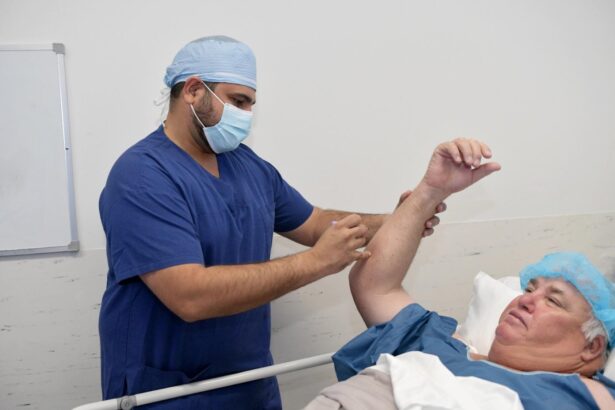
A total shoulder replacement is the third most common joint replacement, after knee and hip. It is a surgical procedure in which the damaged or diseased shoulder joint is replaced with artificial joint components made of metal, plastic, or ceramic, called a prosthesis.
At Midwest Orthopaedics, total shoulder replacement surgery utilises 3D-printed, patient-specific instruments (PSI), 3D anatomical mapping tools and augmented reality technology.
This technology enables Dr Singh to carry out evaluations and to make accurate decisions based specifically on your ‘individual anatomy’. This is important because we all move differently, and these different movements between person to person can directly affect how the implant performs after surgery. By adopting this technology, Dr Singh closes the gap between the precisely engineered prosthesis being implanted during your procedure and your anatomy.
This added support in surgical accuracy is why Dr Singh performs all his total shoulder replacement procedures using patient specific instrumentation technology unless there is a specific reason not to.
Anatomy of the shoulder
The shoulder is a complex ball-and-socket joint that allows the arm to rotate with a circular movement with the ability to hinge out, up and away from the body. It consists of several bones, muscles, tendons, ligaments, and other soft tissues, working together to provide stability and mobility to the joint.
The primary bones in the shoulder joint are the humerus and the scapula. The humeral head articulates against the socket of the scapula, called glenoid, during movement. The surface of the bones is coated with a smooth tissue called articular cartilage. The cartilage, together with a substance called synovial fluid, prevents the bones from rubbing against each other and causing pain.

The shoulder is surrounded by several muscles that help to move and stabilise the joint. The rotator cuff muscles, including the supraspinatus, infraspinatus, teres minor, and subscapularis, attach to the scapula and help to rotate and lift the arm. The deltoid muscle, located on the outside of the shoulder, helps to lift the arm and move it away from the body.
Overall, the shoulder anatomy is a complex and intricate system of bones, muscles, tendons, ligaments, and other soft tissues that work together to provide strength and mobility to the joint.
Arthritis of the shoulder
Shoulder arthritis is damage to the cartilage inside the shoulder joint.
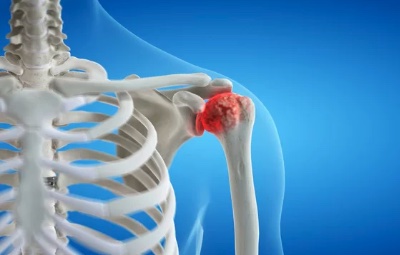
Osteoarthritis is the most common form of arthritis in the shoulder. It is a degenerative, “wear-and-tear” type of arthritis that occurs most often in older people, although it can occur in younger people too. With osteoarthritis, your cartilage deteriorates, and your bones start to rub directly against each other causing pain.
There are two joints within the shoulder that can be affected by osteoarthritis. The main joint that provides most of the shoulder motion is a ball-and-socket joint called the glenohumeral (G-H) joint. This is where the humerus (arm bone) meets the scapula (shoulder blade). The humeral head is the ball side. The glenoid part of the scapula is the socket side. A soft tissue bumper called the labrum deepens the socket. The other smaller joint in the shoulder that does not provide much motion is the acromioclavicular (A-C) joint. This is the joint that connects the collarbone and the scapula.
Osteoarthritis pain will often be felt in the back of your shoulder. It can occur in one shoulder or in both, and the symptoms and pain may come and go depending on the time of day and even with changes in the weather. Other symptoms may include stiffness, a loss in flexibility and swelling. The pain can become worse over time, it can limit your range of motion, and is often extremely uncomfortable, reducing your ability to perform your normal day-to-day activities.
The other common form of arthritis in the shoulder is cuff tear arthropathy which occurs when there is a rotator cuff tear in the shoulder. A rotator cuff tear is a common injury that involves a tear in one or more of the tendons that attach the muscles of the rotator cuff to the bones of the shoulder joint. When a rotator cuff tear is left untreated, it can cause the humeral head (the ball of the upper arm bone) to shift upward in the joint, which can result in rubbing against the acromion (a bone on top of the shoulder blade). This can lead to the development of arthritis in the shoulder joint, known as cuff tear arthropathy.
Suitable candidates for shoulder replacement surgery
The goal of total shoulder replacement surgery is to improve your function in daily life so, if you have been consistently experiencing severe shoulder pain, if the pain is affecting your ability to perform routine tasks such as getting dressed, reaching overhead, or carrying objects and non-surgical interventions such as pain relief, physiotherapy and injections are no longer helpful, total shoulder replacement surgery may be an option for you.
It is important to understand however that total shoulder replacement surgery is an elective operation and whilst Dr Singh can advise and recommend options, the final decision must be yours. Also, not everyone with shoulder pain is a suitable candidate for shoulder replacement surgery so a thorough evaluation by Dr Singh can help determine if this procedure is appropriate.
Benefits of a shoulder replacement
The main benefits of a successful shoulder replacement include a significant reduction in the symptoms of arthritis including a reduction in shoulder pain, improved range of motion and function of the shoulder joint and an overall improvement in the quality of your life. Your everyday activities and your social life should no longer be limited by pain and reduced mobility once you have had total shoulder replacement surgery.
Prosthetic implants used in total shoulder replacement surgery?
The prosthesis in a total shoulder replacement is an artificial articulation composed of metallic and plastic implants. There are two main prosthetic components: the humeral component, which replaces the ball of the upper arm bone, and the glenoid component, which replaces the socket of the shoulder blade.
In an ANATOMIC TOTAL SHOULDER REPLACEMENT, The humeral head is replaced with a metallic head assembled on a metallic stem. The glenoid is replaced with a plastic component. The anatomic solution is usually recommended for patients whose rotator cuff is in good condition.
In a REVERSE TOTAL SHOULDER REPLACEMENT: the implant is designed for patients who have rotator cuff tears or other structural abnormalities that make an anatomic replacement less effective. The implant reverses the ball-and-socket relationship of the shoulder joint, with a metal ball attached to the shoulder blade and a plastic socket attached to the upper arm bone and is usually recommended for patients with cuff tear arthropathy.
The choice of implant depends on factors such as the patient’s age, activity level, and the extent of damage to the shoulder joint. Dr Singh will discuss these options with you and make a recommendation based on your individual needs.
Primary and Reverse shoulder replacement
Primary shoulder replacement surgery and reverse shoulder replacement surgery are two different procedures that are used to address different types of shoulder conditions.
Primary shoulder replacement surgery is also known as anatomic total shoulder arthroplasty. This procedure involves removing the damaged or diseased portions of the shoulder joint and replacing them with a prosthetic implant. The implant includes a metal ball that replaces the humeral head (the ball-shaped top of the upper arm bone) and a plastic socket that replaces the glenoid (the socket-shaped portion of the shoulder blade). This surgery is generally recommended for patients with severe shoulder arthritis or other degenerative conditions that have not responded to non-surgical treatments.
Reverse shoulder replacement surgery is a procedure that is used to treat patients who have a rotator cuff tear and cuff tear arthropathy, a condition in which a rotator cuff tear causes arthritis in the shoulder joint. In this procedure, the implant is reversed, with the metal ball attached to the shoulder blade and the plastic socket attached to the upper arm bone. This reversal allows the deltoid muscle (the large muscle that covers the shoulder) to take over the function of the damaged rotator cuff muscles, allowing the patient to regain strength and function in the shoulder joint. This surgery is generally recommended for patients who have a large rotator cuff tear and limited range of motion in the shoulder.
Both primary and reverse shoulder replacement surgeries are major surgical procedures that require a period of recovery and rehabilitation. The choice of surgery depends on your individual condition and the recommendation of Dr Singh. It is important to discuss the benefits and risks of each procedure with Dr Singh in order to make an informed decision about the best treatment option for the patient.
Technology and shoulder replacement surgery
Technology plays an important role at Midwest Orthopaedics especially in total shoulder replacement procedures because of the added benefits it provides to our patients:
PATIENT MATCHED TECHNOLOGY
A patient-specific shoulder replacement system allows Dr Singh to plan out your procedure in detail before you are on the operating table. Using three-dimensional CT images (computerised tomography) from your CT /MRI scan, Dr Singh, along with a team of engineers create a 3D template of your operative shoulder prior to surgery which enables him to choose the correct size implant more accurately for you and plan the exact location for where the implant components will be attached in surgery.
These patient-specific cutting guides (surgical instruments), provide a personalised solution for you as our patient, and bridges the gap between the precisely engineered implants being used in surgery and your individual anatomy.
The total shoulder replacement surgery process
- GP REFFERAL – If you have shoulder osteoarthritis (OA), your GP will refer you to an orthopaedic surgeon if they consider you may be a potential candidate for total joint replacement (TJR) surgery. It is not clear which patients end up having this surgery.
- BOOK AN APPOINTMENT – At your appointment, Dr Aman Singh will record your medical history, examine you and review any relevant radiology. If any further scans are required, these will be requested and once the diagnosis has been confirmed Dr Singh will discuss the non-surgical and surgical options of surgery.
If no surgery is required, Dr Singh may refer you to a physiotherapist for non-surgical management. If surgery is required, he will go through the risks and benefits of the procedure and
the following tests and conditions will be necessary:
PHYSICAL EXAMINATION – Dr Singh will perform a complete physical examination to confirm that you do not have any conditions that could interfere with the surgery or the outcomes.
GENERAL HEALTH – If you smoke, you should make every effort to STOP at least 2 weeks (or even longer) before your operation. Smoking increases your risk of infection and slows down wound healing. If you have ever needed an incentive to quit, having surgery is it!
MEDICATIONS – Provide Dr Singh with a complete list of any medications you are taking especially, any blood thinning medications. He will inform you if you need to stop or change any medications prior to surgery.
- CHECK YOUR PRIVATE HEALTH INSURANCE COVER – Call your private health insurance provider to check that you are covered for joint replacement surgery.
- PRE-SURGERY PHYSIOTHERAPY – Seeing your Physiotherapist prior to surgery will greatly improve and hasten your recovery ‘post-surgery’. Strengthening muscles and learning the exercises before being affected by the pain and medication post operatively will increase your understanding as to what is required during rehabilitation. If you do not have a usual physiotherapist, Midwest Orthopaedics are able to recommend a suitable physiotherapist for you.
- CT/MRI SCAN– Dr Singh will arrange for you to have a CT/MRI scan of your shoulder at least, 6 weeks prior to your surgery date for the engineers to create a 3D model of your shoulder and create your personalised surgical instruments.
Replication of your knee
The engineers create a 3D model of your shoulder using the images taken in your CT/MRI scan.
Analysis and Planning
Dr Singh closely analyses your 3D shoulder model and then makes any necessary adjustments to your surgical plan so that the final position of your shoulder implant can be precisely matched to your specific anatomy.
- LODGE YOUR PAPERWORK WITH THE HOSPITAL – Prior to surgery, you will attend a pre-admission clinic appointment at the hospital. This is normally organised 1–2 weeks before your scheduled surgery. At this appointment, you will have routine blood & urine samples taken and an ECG.
- EQUIPMENT REQUIRMENTS – Prior to your procedure, an Occupational Therapist from the hospital will call you to conduct a brief assessment of your post-op needs. This will include details regarding what equipment you will require to assist you during your rehabilitation, and how to safety proof your home.
- PACK YOUR BAG FOR THE HOSPITAL – Be sure to pack a small bag of things to take with you to the hospital including your regular medications, some clean clothes, and your toiletries. Your hospital stay following a total shoulder replacement is usually 3 nights but may be longer, depending on your individual situation.
- YOUR SURGICAL INSTRUMENTS ARE PRODUCED
Your surgical cutting guides and the 3D model of your shoulder are manufactured, sterilised, and sent across to the hospital in time for your procedure.
- TOTAL SHOULDER REPLACEMENT SURGERY
Dr Singh uses your customised surgical instruments and the 3D replica of your shoulder in surgery to achieve the most accurate implant sizing and position for you.
The shoulder replacement surgical procedure

Your total shoulder replacement procedure starts off with you being wheeled into the operating bay and meeting with a member of the anaesthesia team. The most common types of anaesthesia used in a total shoulder replacement are general anaesthesia (you are put to sleep) or spinal, and/or regional nerve block anaesthesia (you are awake, but your body is numb from the waist down).
The anaesthetist, with your input, will determine which type of anaesthesia will be best for you.
After the anaesthetist has administered your anaesthetic and the nerves that supply your arms and shoulder have been numbed, Dr Singh will make an incision, starting at the top and front of the shoulder and curving along the deltoid muscle. He then cuts through deeper tissue, including one of the rotator cuff tendons to enter the shoulder joint. The top of the upper arm bone, called the humeral head, is dislocated from the socket of the scapula, or glenoid.
Dr Singh will examine the humeral neck, which is the area just below the rounded head of the humerus. He uses a tool called an osteotome to remove any bone spurs that may have developed on the humeral neck as the result of arthritis.
Dr Singh uses a bone saw to remove the humeral head and prepares the humerus bone for the prosthetic humeral stem. The humeral stem is a narrow, tapered metal shaft that fits several inches down inside the humerus. The top of this stem is designed to hold a prosthetic ball that will replace the natural humeral head.
Dr Singh then uses a special tool called a reamer to smooth and shape the shoulder socket (glenoid) and prepare it for its prosthesis. The artificial socket, or glenoid prosthesis, is usually made of polyethylene and has a smooth, slightly concave design to facilitate movement with the prosthetic humeral head. A new socket is usually backed by either a few short pegs or a flat, straight edge called a keel (which is shaped like the keel of a boat). The pegs or keel fits into the natural bone. The prosthetics may be adhered to the natural bone with bone cement or they may be cement-less (sometimes called “press fit”) components. The fast-acting bone cement takes only about 10 minutes to set.
After the humeral stem is secured in place, a temporary prosthetic ball is attached to its top. Different sizes of the temporary ball will be used to test the stability of the new joint before the final size is determined. The artificial humeral head has a shape and size suited your existing anatomy, and is specially designed to move with the artificial socket. The exact model selected is based on Dr Singh’s pre-surgical planning and observations during surgery.
Dr Singh inserts the temporary ball into the new socket and moves the shoulder around, checking to make sure the shoulder joint has ease of motion and does not dislocate. He will then then dislocate the joint, remove the temporary or trial component, and attach the final ball prosthetic. Dr Singh inserts the ball into the new socket, checking again for ease of movement and dislocation. The muscle and other soft tissues that were cut are repaired and the skin incision is stitched or stapled back together.
The whole procedure takes about ninety minutes for Dr Singh to complete.
After total shoulder replacement surgery
Immediately after total shoulder replacement surgery, you will be wheeled into a recovery room on your ward bed and given oxygen to help you breath. Leads will be on your chest to monitor your heart rate, and an intravenous line (drip) will be in your arm which dispenses fluid and paracetamol for the first 24-36 hours following your procedure.
When you wake up in the recovery ward, you may feel a bit groggy. Dr Singh and the hospital team will monitor you, checking your blood pressure, temperature, and pulse. Post-operative x-rays will be performed in recovery so that Dr Singh can check the position of your prosthesis and after 45 minutes – 1 hour, you will be transferred back to your room on the ward.
The nursing team at the hospital will help you perform your normal day to day activities as required.
Your hospital stay following total shoulder replacement surgery is usually 2 – 4 nights, however, may be longer based on your individual situation. Dr Singh takes into consideration your age, general health, whether you have help at home among other factors when determining your required stay in the hospital.
Follow-up appointments with Dr Singh following total shoulder replacement surgery are 1 month, 3 months then, 12 months post-surgery.
Shoulder replacement surgery risks
The vast majority of shoulder replacement surgeries are successful however, complications can occur even when surgeries are done properly and go smoothly. The following is a list of possible complications, and the measures Midwest Orthopaedics uses to mitigate them from occurring:
Blood clots: Clots (deep venous thrombosis or DVT) can occur in the veins of the legs after any surgery. Occasionally these clots travel to the lungs causing a clot in the lung (pulmonary embolus or PE). A pulmonary embolus has the potential to cause death so, if you develop pain or swelling in your calf post-surgery or find yourself suddenly short of breath, please contact Midwest Orthopaedics, the hospital, or your local GP immediately.
To reduce the risks of clots forming, Dr Singh will prescribe aspirin to thin your blood and he uses special compression sleeves during and after your operation. The Midwest Orthopaedics team will also spend time educating you on calf muscle exercises to be performed after surgery and ensure the hospital team get you up and mobile as quickly as possible after surgery.
Infection: This is a very serious complication which occurs in approximately 1% of cases.
Although uncommon, the Midwest Orthopaedics team take the following precautions to further minimise this risk:
- prior to surgery, your skin is tested to ensure resistant organisms are not present
- your limb is prewashed with antiseptic prior to surgery
- intravenous antibiotics are used at the time of surgery
- the surgical team are required to wear special, self-enclosed theatre gowns
- any infection that develops after surgery is treated immediately
Delayed infection has been reported years after joint replacement and appears to be related to the ability of the implants, in general, to harbor bacteria transported by the blood stream from other sites of the body. Bladder or kidney infections can be a source, but dental abscesses, infected ingrown toenails, or skin infections may also be a significant danger to a joint implant. If dental surgery, bladder surgery, bowel surgery or rectal surgery is planned, the surgeon or dentist should be informed that you have had a joint replacement.
If an infection does occur, it is important to seek treatment immediately as it is often possible to save the prosthesis if treated early enough. If this is not possible, then it may be necessary to remove the prosthesis and give antibiotics through a drip for a six-week period.
A new prosthesis can usually then be re-implanted once the infection has resolved.
Fracture: Although rare, it is possible for the bones of the humerus or glenoid to break during or after surgery. Dr Singh avoids this risk by taking appropriate care during insertion and using a shoulder replacement system with many size options.
Prosthesis loosening: A small percentage of patients require revision surgery because of excessive wear or loosening of the prosthesis. This may cause pain and joint instability, which can affect the shoulder’s range of motion and function.
Rotator cuff damage: The rotator cuff muscles are more prone to injury following surgery. To decrease the risk to the rotator cuff problems:
Prior to surgery, Dr Singh will carefully evaluate the rotator cuff muscles for damage that might be made worse by a traditional shoulder replacement.
During surgery, Dr Singh will make all efforts to minimise soft tissue damage.
After surgery, the patient must learn how and when to keep the shoulder immobilised and supported. The patient must also learn what movements are safe and what movements pose a risk to the healing shoulder.
Implant malposition: Despite the best intentions and effort, it is possible for a prosthesis to be inserted at a slight angle or rotated. To avoid this risk, Dr Singh utilises advanced software in the operating room during your procedure which assists him during the intra-operative assessment of your replacement.
Joint dislocation or partial dislocation (subluxation): Sometimes, the shoulder joint can dislocate because muscles and ligaments have not yet repaired themselves to provide support to the joint. This risk decreases as the muscles around the shoulder joint are strengthened physiotherapy.
Blood vessel or nerve injury: The surrounding nerves and blood vessels can be injured during surgery, though this risk is low.
Allergies to metal: Metal allergies, particularly nickel, can occur in some people. The prostheses Dr Singh uses are made of titanium, chrome cobalt and polyethylene which do not contain nickel so should not cause an allergy.
The patients general and mental health: As with all surgeries, patients can develop problems such as a heart attack or stroke during or after an anaesthetic. This is often related to health problems present before the surgery though and is why Dr Singh arranges a specialist physician review prior to your procedure.
Discovering any potential problems before surgery drastically reduces the risk of any of these complications from occurring.
How much does total shoulder replacement surgery cost?
Typically, costs associated with total shoulder replacement surgery as a privately insured patient at Midwest orthopaedics include your initial consultation fee, review consultation fee & Dr Singh’s surgical fees. Other related charges include the Anaesthetist, the hospital fees, implants/prosthesis and any in-patient pathology and radiology charges if x-rays or scans were required:
Your level of healthcare and your provider greatly influence your out-of-pocket expenses, so we recommend that you check with your health fund prior to booking in for surgery.
Self-Insured Patients
An increasing number of people without private health insurance are choosing to “Self-Insure” or pay for their own surgery. This is because, even though Dr Singh operates in the public sector at Geraldton Regional Hospital, the waiting list to even meet with him can be long (too long), followed by even longer waiting lists for their operation.
All the private hospital fees associated with your surgery are ho
 Christmas Operating Hours
Christmas Operating Hours 

